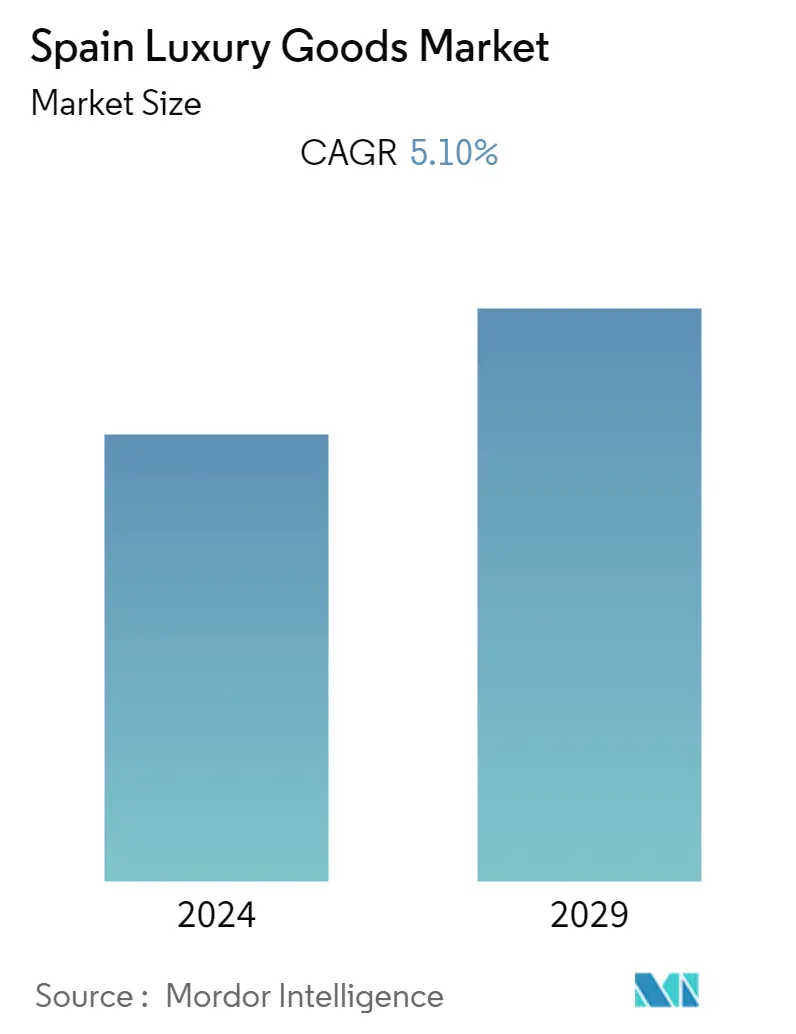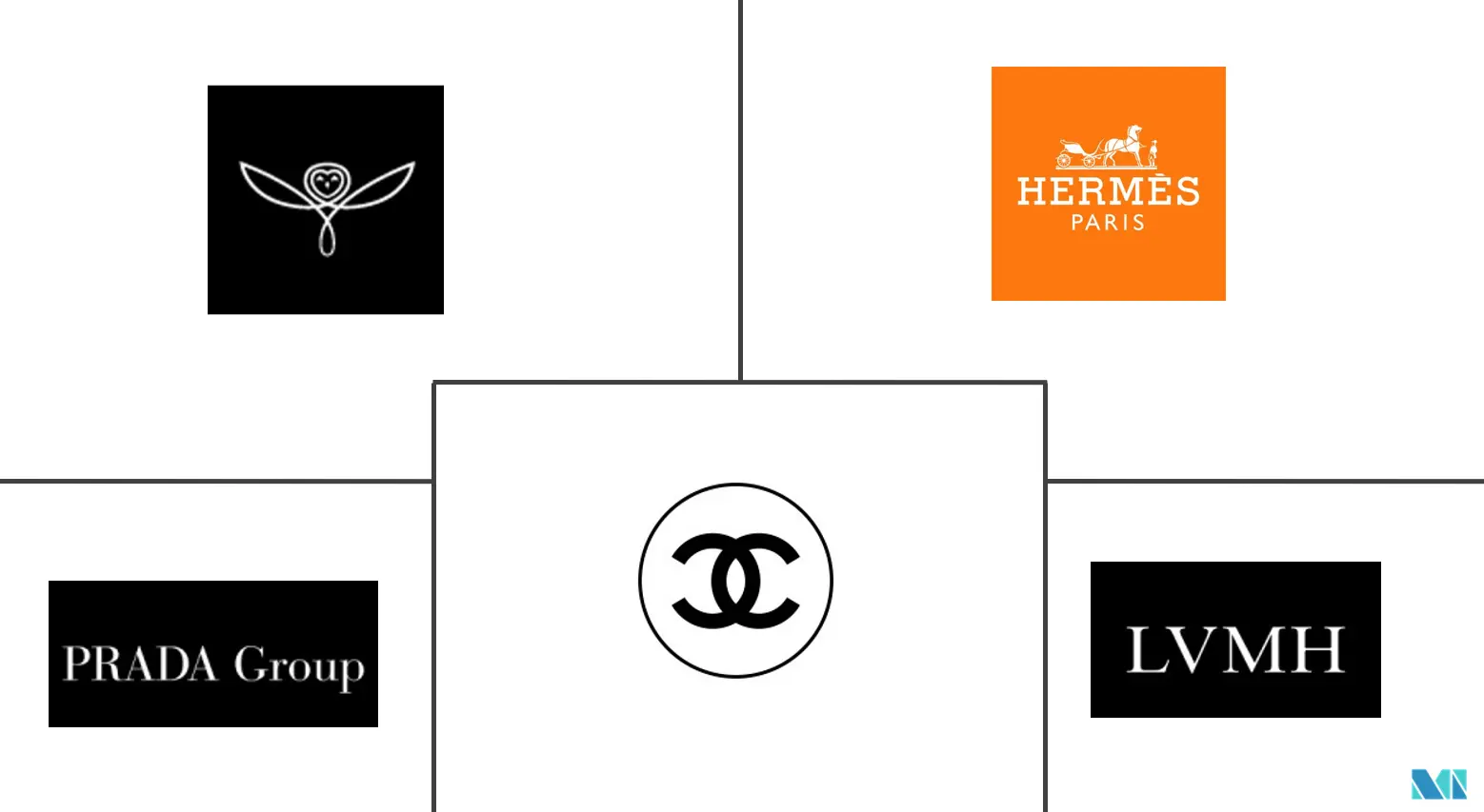Market Size of Spain Luxury Goods Industry

| Study Period | 2019 - 2029 |
| Base Year For Estimation | 2023 |
| Forecast Data Period | 2024 - 2029 |
| Historical Data Period | 2019 - 2022 |
| CAGR | 5.10 % |
| Market Concentration | Low |
Major Players
*Disclaimer: Major Players sorted in no particular order |
Spain Luxury Brands Market Analysis
The Spain luxury goods market is forecasted to witness a CAGR of 5.1% during the forecast period (2022 - 2027).
The Spain luxury goods industry has been heavily impacted by the Covid-19 crisis. Tourist arrivals have decreased as a result of the lockdown and restrictions enforced, compelling them to stay at home. Online purchasing for luxury items, on the other hand, has flourished and therefore the pandemic has highlighted the need for digitization as a key strategy for luxury brands in the forecasted years. Further, the market performance during the second quarter of 2020 demonstrates that luxury brands are ready to adopt more online channel marketing which in turn is anticipated to increase online sales of luxury goods in the future. For instance, in June 2022, Amazon launched its luxury fashion platforms in key European countries including Spain. In Spain, luxury stores have been launched to showcase ready-to-wear collections from established and emerging brands including Christopher Kane, Dundas, Elie Saab, Mira Mikati, Rianna + Nina, Boglioli, Jonathan Cohen, and Altuzarra. The luxury brands are anticipated to distribute through their own or Amazon's warehouse and will offer free returns and delivery services.
Over the medium term, millennials are considered to be the target consumers for luxury goods, as the generation is more open to spending on life's luxuries supported by financial independence and significant disposable income. Further, the increased exposure to the global and regional fashion trends due to the rising use of social media platforms is the key factor shaping consumer buying behavior. In response to this trend, luxury brands are collaborating with social media influencers to create purposeful promotional campaigns, which in turn encourage affluent consumers to purchase luxury fashion products.
Additionally, modern consumers are concerned about an ever-worsening climate crisis and desire to make a difference by adopting sustainable fashion trends. Therefore, luxury businesses' sustainability practices have a significant impact on the purchasing decisions of millennial consumers, which in turn promotes R&D and innovation to develop a range of luxury goods with the use of eco-friendly materials and ethical manufacturing methods. For instance, Spanish brands specializing in sustainable luxury fashion goods include - AVASAN, Flamingos' Life, Castañer, TwoThirds, and Balenciaga, among others.
Spain Luxury Brands Industry Segmentation
Luxury goods refer to premium or elite quality products which are expensive as compared to conventional accessories. The Spain luxury goods market is segmented by type and distribution channel. By type, the market is categorized into clothing and apparel, footwear, bags, jewelry, watches, and other luxury goods. By distribution channel, the market is segmented into single-brand stores, multi-brand stores, online stores, and other distribution channels. The report offers market size and forecasts in terms of value (USD million ) for all the above segments.
| By Type | |
| Clothing and Apparel | |
| Footwear | |
| Jewellery | |
| Watches | |
| Bags | |
| Other Luxury Goods |
| By Distribution Channel | |
| Single-brand Store | |
| Multi-brand Stores | |
| Online Stores | |
| Other Distribution Channels |
Spain Luxury Goods Market Size Summary
The Spanish luxury brands market is experiencing a transformative phase, driven by the increasing importance of digital channels and the evolving preferences of consumers. The Covid-19 pandemic significantly impacted the market, leading to a surge in online shopping for luxury goods as traditional retail faced challenges due to lockdowns and travel restrictions. This shift has underscored the necessity for luxury brands to enhance their digital presence, with platforms like Amazon expanding their luxury fashion offerings in Spain. The market is characterized by a diverse range of international and regional brands, with companies like Loewe and Puig playing pivotal roles in the luxury landscape. The influx of tourists, particularly from Asia, the Middle East, and Latin America, further bolsters the market, as Spain remains a favored destination for luxury shopping.
Millennials are emerging as a key consumer segment, influenced by their financial independence and exposure to global fashion trends through social media. This demographic's preference for sustainable and ethically produced luxury goods is prompting brands to innovate and adopt eco-friendly practices. Spanish brands such as AVASAN and Flamingos' Life are at the forefront of this trend, aligning with the growing consumer demand for sustainability. The market's growth is also supported by the expansion of e-commerce, with luxury brands leveraging online platforms to reach a broader audience. The competitive landscape is marked by strategic mergers, acquisitions, and partnerships among major players like LVMH and Kering Group, aiming to strengthen their market position and cater to the evolving consumer base.
Spain Luxury Goods Market Size - Table of Contents
-
1. MARKET DYNAMICS
-
1.1 Market Overview
-
1.2 Market Drivers
-
1.3 Market Restraints
-
1.4 Porter's Five Force Analysis
-
1.4.1 Threat of New Entrants
-
1.4.2 Bargaining Power of Buyers/Consumers
-
1.4.3 Bargaining Power of Suppliers
-
1.4.4 Threat of Substitute Products
-
1.4.5 Intensity of Competitive Rivalry
-
-
-
2. MARKET SEGMENTATION
-
2.1 By Type
-
2.1.1 Clothing and Apparel
-
2.1.2 Footwear
-
2.1.3 Jewellery
-
2.1.4 Watches
-
2.1.5 Bags
-
2.1.6 Other Luxury Goods
-
-
2.2 By Distribution Channel
-
2.2.1 Single-brand Store
-
2.2.2 Multi-brand Stores
-
2.2.3 Online Stores
-
2.2.4 Other Distribution Channels
-
-
Spain Luxury Goods Market Size FAQs
What is the current Spain Luxury Goods Market size?
The Spain Luxury Goods Market is projected to register a CAGR of 5.10% during the forecast period (2024-2029)
Who are the key players in Spain Luxury Goods Market?
Kering Group, Prada Holding S.P.A., Hermès International S.A., Chanel SA and LVMH Moët Hennessy Louis Vuitton are the major companies operating in the Spain Luxury Goods Market.

